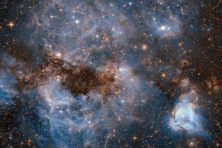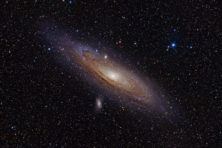Eye On the Night Sky: Aspiration and Inspiration
- Share
- Tweet
- Pin
- Share

by Mike Egan, Door Peninsula Astronomical Society
In 2002, not long after the Door Peninsula Astronomical Society was founded in 1998, Ray Stonecipher, known to many Pulse readers, invited a few of us to join in a collaborative effort of professional astronomers, high school students and amateurs interested in researching a particular topic. It would be the first such collaboration ever.
And so, on the amateur side, members such as Jim Maki, Kent Seely and I met with Ray, Dr. David Barnaby, an astronomy professor from the University of Western Kentucky, a group of talented students from Sturgeon Bay High School (SBHS), and under the aegis of the Sloan Digital Sky Survey (SDSS), prepared to work together doing some original research. In charge of all the details and the lead collaborator was a wonderful teacher from SBHS, and a native of the county, Kate Meredith.
We began with a series of presentations by Ray and Dave to bring us up to speed on the topic: Active Galactic Nuclei, variable Quasars, and Seyfert Galaxies. The tools the group had to use were raw data as little as a day old from the SDSS, computers, their own innovative inquiry methods and the joys of discovery and reporting. It was a wonderful week, a wonderful experiment, and old and young successfully performed some original research. In short, it was a Kate Meredith week.
Back-filling a bit: Kate was Jim Maki’s student in eighth grade, 1978-79 (please, politely, do not do the arithmetic!). In the fall of 1987, she was a student teacher. I realize many of you know Jim Maki. More than know, you respect Jim Maki. To walk down Third Avenue with Jim is a treat: so many of his former students greet him, “Hi, Mr. Maki!” Always the “Mr.” even when he says it’s OK to call him Jim. He, indeed, has inspired many. And they all respect him.
Jim inspired Kate. She started her teaching career teaching biology and general science after getting her Master’s degree, until Jim said to her: “Hey, I need someone at the high school to teach astronomy.” Kate agreed though she humbly admitted to knowing only the phases of the Moon. Ray came on the scene and urged her to get trained with Hands-On Universe. This training was held at the Adler Planetarium and the teachers from Yerkes [Observatory in Williams Bay, Wis.] made several trips up to our Leif Everson Observatory to help Kate with our mount and dome problems. “Ray held my hand through the stupid days and helped me get everything rolling and before we knew it, I was teaching a night class at the Observatory.”
In too short a time, Kate’s husband Chris took his family to Trempealeau for him to pursue a different career, initially as a police school liaison officer. Kate and her family sadly left Sturgeon Bay.
Fast forward a few years. Ray’s estate provided a small gift to the Yerkes Observatory. (He died Aug. 27, 2015). And guess who invited a group of us down for a private night with the incredible Alvan Clark telescope at Yerkes? Yep, Kate! In her role as Interim Director of Education Outreach at the University of Chicago Yerkes Observatory, where her focus has been to build on the legacy of the Yerkes Education Outreach as the leader in accessible and inclusive astronomy and STEM education. So on Oct. 27 of this year, a group of us assembled under the 63’ long telescope, with its 40” refractor lens – the world’s largest refractor telescope still used for scientific research – awed by all we learned of its role in opening up the skies above for research and exploration, and Kate standing by, smiling.
Then we learned that one other of our group, Dave Lenius, also had Mr. Maki as science teacher in middle school. The three gathered under the six-ton telescope tube for this portrait.
Among her many other projects, Kate has an active proposal in play named IDATA (Innovators Developing Accessible Tools for Astronomy) in partnership with the University of North Carolina at Chapel Hill, the University of Chicago Yerkes Observatory, TERC and the University of Arizona at Las Vegas. Soon, annually, at least 20 teachers will work with more than 200 students in the design and testing of accessibility software, the role of computation in astronomy and the production of online imaging software accessible to a community of users previously excluded from astronomy research.
And so the torch of aspiration and inspiration passes to others, and our Jim Maki and Kate Meredith have shown the way.
“Eye On the Night Sky” is a monthly column by the Door Peninsula Astronomical Society. For more information on the organization, visit DoorAstronomy.org.





